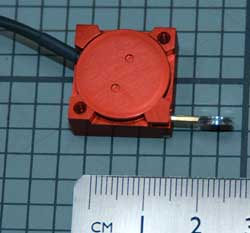
Posted to News on 18th Jun 2008, 21:04
Novel linear actuator is virtually flat when retracted
Kataka is launching a novel type of linear actuator that has the major advantage of retracting to almost zero length, meaning that it can be used in applications for which conventional actuation technologies are unsuitable.

While Kataka has termed the technology the 'segmented spindle', it could also be described as a three-dimensional zip or the Indian Rope Trick. Kataka prefers 'segmented spindle' because it describes the way the spindle (or thrust rod) comprises linked segments. When the actuator is retracted, the segments can be stored in almost any arbitrarily shaped housing but, when the actuator is required to extend, the segments attach rigidly to their neighbours to form a rod that appears to screw outwards from the housing. Kataka has several patents on the technology, with further patents pending.
Typically the segmented spindle design features a helical thread, but the concept can equally well be executed without any thread, or with grooves or keyways that run in an axial direction.
 The Kataka 400 unit shown on this page has a maximum stroke length of 400mm and a retracted length (housing depth) of 50mm. The housing length and width are 380mm and 125mm, respectively. Maximum load is 2000N extending and 1000N retracting, with a speed of 15mm/s for a 1000N load. Operating from a 24V DC power supply, the unit draws a maximum current of 5A and can operate with a 10 per cent duty cycle. It is sealed to IP54 and has M6 mounting holes on all six faces of the housing.
The Kataka 400 unit shown on this page has a maximum stroke length of 400mm and a retracted length (housing depth) of 50mm. The housing length and width are 380mm and 125mm, respectively. Maximum load is 2000N extending and 1000N retracting, with a speed of 15mm/s for a 1000N load. Operating from a 24V DC power supply, the unit draws a maximum current of 5A and can operate with a 10 per cent duty cycle. It is sealed to IP54 and has M6 mounting holes on all six faces of the housing.
To find out more about this innovative actuator, visit www.kataka.dk or view Kataka's animations on YouTube at www.youtube.com/user/kataka1.
Want the latest machine building news straight to your inbox? Become a MachineBuilding member for free today >>















